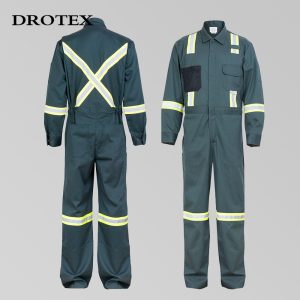A safety clothing coverall protective suit is a type of personal protective equipment (PPE) designed to protect the wearer from various hazards in the workplace or specific environments. These suits are typically one-piece garments that cover the entire body, including the torso, arms, and legs, and sometimes include hoods, boot covers, or integrated gloves for full-body protection.
Key Features of Safety Coverall Protective Suits:
- Full-Body Coverage: Designed to protect the wearer from head to toe, minimizing exposure to hazards.
- Material: Made from specialized materials depending on the intended use, such as:
- Flame-resistant fabrics for protection against heat and fire.
- Chemical-resistant materials (e.g., Tyvek, PVC, or rubber) for protection against hazardous chemicals.
- Waterproof or breathable fabrics for protection against liquids or extreme weather conditions.
- Anti-static or conductive materials for use in environments with explosive or electrostatic risks.
- Sealed Seams: Many suits have taped or sealed seams to prevent penetration of liquids, dust, or chemicals.
- Closure Systems: Equipped with zippers, snaps, or hook-and-loop fasteners for easy wearing and removal.
- Hoods and Elastic Cuffs: Often include hoods and elasticized cuffs at the wrists and ankles to ensure a snug fit and prevent contaminants from entering.
- Visibility Features: Some suits have reflective strips or high-visibility colors for use in low-light environments.
Common Uses of Safety Coverall Protective Suits:
- Chemical Handling: Protects against splashes, spills, or exposure to hazardous chemicals.
- Healthcare and Medical Settings: Used as biohazard suits to protect against infectious agents (e.g., viruses, bacteria).
- Firefighting and Heat Protection: Flame-resistant suits for firefighters or workers in high-temperature environments.
- Construction and Industrial Work: Protects against dust, debris, and mechanical hazards.
- Agriculture and Pest Control: Shields against pesticides, fertilizers, or other agricultural chemicals.
- Hazardous Waste Cleanup: Used in environments with asbestos, radioactive materials, or other dangerous substances.
- Emergency Response: Worn by first responders during chemical spills, natural disasters, or other emergencies.
Types of Protective Suits:
- Disposable Coveralls: Lightweight, single-use suits for short-term protection (e.g., Tyvek suits).
- Reusable Coveralls: Durable suits designed for multiple uses, often made from thicker, washable materials.
- Specialized Suits: Custom-designed for specific hazards, such as radiation suits, hazmat suits, or anti-static suits.
Standards and Certifications:
Safety coveralls must meet specific standards depending on their intended use, such as:
- EN ISO standards (Europe)
- NFPA standards (for fire-resistant clothing)
- OSHA regulations (for workplace safety in the U.S.)
- ASTM standards (for chemical resistance and other properties)
In summary, a safety clothing coverall protective suit is a critical piece of PPE that provides comprehensive protection against a wide range of hazards, ensuring the safety and health of workers in high-risk environments.

